-
Chicken Care
Caring For Chicks / Nutrition / Old Fashioned Remedies
Helpful Poultry Definitions:
*Chick – A baby chicken at the fluffy downy stage.
*Poult – Young poultry or fowl.
*Pullet – A young female chicken at least 20 weeks old which has begun to lay eggs but has not yet moulted.
*Cockerel – Immature male chickens of less than a year’s age.
*Rooster – Sometimes called a ‘Cock’ is an adult male chicken over a year old.
*Hen – Female chicken that has begun to lay eggs or is over 12 weeks of age.
*Layer – A chicken that lays eggs.
*Bantam – A small variety of chicken or miniature breeds.
*Standard Poultry – The American standard, official breed standard for poultry in North America.How To Care For Baby Chicks
Well, you are thinking about getting sweet little baby chicks. Here are a few tips to keep them healthy and happy. Remember, good egg layers begin with proper care when they are babies. There is a real advantage of raising your own chicks, you control their diet, medication and everyday care. Be careful buying grown chickens from different places. Ask questions about their diet and vaccinations before you buy them.
Usually, a minimum order of 25 chicks is required if you purchase online from a hatchery. Ordering with a neighbor is a good way to get the breeds you want without paying for all 25. Your local farm and ranch supply stores will also carry chicks in the spring. They supply a good variety of the top egg laying breeds with no minimum purchase.
Supplies needed:
1. A chick brooder (or place to keep your chicks.) This could be as simple as a cardboard box. Make sure there is room inside for the chicks to run around and play. You also need enough space to have a small feeder and water container.
2. A heat lamp and 2 bulbs. Have an extra bulb in case one goes out. You don’t want your chicks getting cold in the middle of the night if they do not have a heat source. Make sure you get the bulbs that are 125 -250 W. You need your little chicks to stay warm at 95-100 degrees when they first hatch. A regular light bulb will NOT keep them warm enough! I like to purchase the RED heat bulbs, it helps the chicks sleep at night because it is not so bright. It also helps them not peck each other.
 3. A thermometer! Keep a thermometer inside the chick brooder so you can control how cold or warm it is. The thermometer should be 1″ from the bottom of the brooder to know how warm it is by the floor. Lower or raise your heat lamp until the temperature is 95 degrees. Lower temperature 3-5 degrees every week until they are use to 75 degrees. If you see your chicks standing with their wings spread out they might be too warm. If they are all clumped together they might be too cold and could step on each other which could result in death from smothering. Keeping the proper temperature will help your chicks get off to a good start.
3. A thermometer! Keep a thermometer inside the chick brooder so you can control how cold or warm it is. The thermometer should be 1″ from the bottom of the brooder to know how warm it is by the floor. Lower or raise your heat lamp until the temperature is 95 degrees. Lower temperature 3-5 degrees every week until they are use to 75 degrees. If you see your chicks standing with their wings spread out they might be too warm. If they are all clumped together they might be too cold and could step on each other which could result in death from smothering. Keeping the proper temperature will help your chicks get off to a good start.4. Feeder and water container. There are a couple different kinds in your local ranch stores. I like the screw on attachments for water feeders. The red plastic ones will fit on a mason jar. Tip an old pie plate over and place your water feeder on top to keep the chicks from stepping in the water. I also use the vertical round feed buckets with a round tray at the bottom as the hens get older. It allows everyone to share and I can see how full the bucket is. It is a good idea to purchase a poultry fountain with a heating element in the tray so you have one feeder you can use all year round if you freeze in the winter. When the weather gets cold, simply plug in the tray to a power source and your water stays thawed all winter. I also like to cover my water and food with feeder covers. This helps the hens not defecate or scratch in the containers.
5. Chick Start feed. If your chicks are vaccinated for coccidiosis, you do not need to feed them medicated feed. Ask to see if your chicks have been vaccinated before you purchase them. If you are able to order them with the option to vaccinate, pay a couple extra dollars to do so. If your chicks have not been vaccinated, give them medicated feed until they are 6-8 weeks old. You can also have your chicks vaccinated for Merricks disease only and then give them medicated chick start for the coccidiosis. Be sure to check the label!
6. Pine shavings or Cedar shavings (with no additives) to keep those little girls warm and dry. Be sure to keep the brooder clean. If anything gets wet, replace brooder with new shavings. Pine shavings are used when I get chicks, however, as soon as I move them to the coop, I choose to use cedar shavings and mix it with food grade diatomaceous earth. The DE absorbs the aromatics of the cedar and keeps the coop dry. My coop also has excellent ventilation so I do not worry about using cedar.
7. Food Grade Diatomaceous Earth to keep lice and mites off! Yes, chicks can get lice too. Early signs of poultry head lice is the chick stretching out its neck and falling on its back. Check and dust once a month for lice on chicks if you notice an outbreak in your flock. Put a little DE in your fingers and rub through the neck and around head. Many chicks thrive better in early spring than in summer because disease can multiply more rapidly in warmer weather. Later, when the chick is a young hen, she is more susceptible to body lice and mites. Keep DE on hand at all times to dust for these nasty pests! Dusting directions for hens are continued below…
**pick some fresh (short) spring grass for you chicks, it helps them stay regular.**
**Always keep water clean, make sure water and feed containers stay full.**
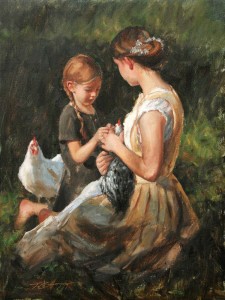
Feeding Schedule for Brown Egg Layers
and Leghorns:0-6 weeks 20-21% protein chick starter
6-10 weeks 16-19% protein pullet grower
18-22 weeks at onset of egg production 16-18% protein layer diet (20% layer feed is fine for free range hens.) As soon as hens begin to lay, offer oyster shell as a free choice, available at all times during the day.
Dual-purpose breeds like Plymouth Rock, Rhode Island Red, Delaware, etc.
0-6 weeks 20-21% protein chick starter
6 weeks prior to egg production15-19% protein pullet grower/developer
At onset of egg production 16-18% protein layer diet (20% layer feed is fine for free range hens..especially heavy breeds.) As soon as hens begin to lay, offer oyster shell as a free choice, available at all times during the day.
Giving your hens the proper feed diet will help with egg production and overall health. I add 5% food grade Diatomaceous Earth to my hens feed as a de-wormer. They have a great feed conversion ratio and lay great!
Chicken Treats:
Chickens love treats. Avoid too much salt or sugar when giving your chickens table scraps. Here is a list of some of the treats that are safe for your hens in ABC order:
Apples, Asparagus, Bananas, Barley (cooked) Beans (cooked), Beets, all kinds of Berries, Bread (in moderation, wheat is best), Broccoli, Cauliflower,Cabbage, Carrots, Cheese, Cottage Cheese, Corn, Crickets (alive), Cucumbers, Fish, all kinds of Fruit, Grains, Grapes, Grits (cooked), Lettuce, Meal-worms (available at pet stores), Meat (in moderation), Melons, Milk (fresh or sour), Oatmeal, Peas, Peppers (bell), Popcorn (popped with no butter and salt), Potatoes (but not the peeling, they are toxic!), Pumpkins, Raisins, Rice (cooked only), Scratch, Sprouts, Summer Squash, Sunflower Seeds (with our without shell), Tomatoes, Watermelon and Yogurt (plain.) Do not feed spoiled or moldy food to your hens.
Our chickens favorite treats have been bananas, meal-worms, berries (especially cherries), cheddar cheese, sour milk, cottage cheese, tomatoes and yogurt. We let our hens run around our yard free range, so they have plenty of greens and bugs. If you are fully fenced, it is a great way to raise chickens. They have plenty of room and they will fertilize your grass. Make sure you fence your garden!
Nutrition and Care for the Winter:
Providing your hens with the nutrition they need in winter will help them maintain a healthy weight to keep them warm. Chickens actually do very well in the cold and still love to get outside. Give them extra greens in the colder months when grass is not available. Hang some broccoli or lettuce inside the coop for them to peck at. Throw some scratch grains or whole wheat in the afternoon for them to peck around and get some exercise. This will also stay in the crop while they are roosting and keep them fuller and help them keep warm. Put a little Vaseline on their comb and toes to help reduce frost bite.
If you would like your hens to keep laying in the winter, provide them with a light source. Chickens eyes cannot adjust to darkness very fast, so set a timer for the light, early enough for the hens to have about 14 hours of light. Let the sunset put them to bed naturally so their eyes can adjust to the darkness and they will go to roost. Chickens metabolism slows down in the winter and they keep warm very well on their own! If you are worried about them being cold, you can keep a heat lamp in your coop on especially cold days. You have to be careful not to cause condensation (from the heat) inside the coop which can cause frost in areas. The heat lamp will not heat up the entire coop, just a small area if the hens decide to use it.
There are a few homemade ways to keep your hens water from freezing. I like the poultry fountains with a heating element in the bottom tray. You can plug it into an outlet (using an extension cord if needed) and it keeps the water from freezing. To purchase one costs about $40 but well worth not worrying about the water freezing every night.
 Some may give a little extra vitamin D to help egg production. I find they have enough in their grain if purchased from a ranch store. It already has all the vitamins in the feed, so giving extra vitamin D is optional but might be a good idea if you want more eggs in winter.
Some may give a little extra vitamin D to help egg production. I find they have enough in their grain if purchased from a ranch store. It already has all the vitamins in the feed, so giving extra vitamin D is optional but might be a good idea if you want more eggs in winter.Chickens naturally slow down their laying in the winter not just because of the cold, sometimes they will go through a molt depending on the age and breed. Molting usually begins around 18 months of age and can last 3-4 months or longer. The hens go this process of loosing old feathers and gaining new ones. Your hens will molt about the same time once a year (depending on the breed, it could be twice a year.) After the molt, egg laying goes back to normal. If your hen is molting off schedule, she might have a parasite.
Another thing I do is uncover the snow around the fence where the dirt is so they can have some grit. It is harder for the hens to find the grit they need in the winter, so make sure you provide them with it. Continue to offer oyster shell as a free choice but not as a substitute to grit. Also…Let them out! Let them out! Chickens still love to get out and run around, even in the winter! Shovel little paths in the snow for a little play room for your hens. Sometimes you can find grass under the snow for them to eat if they are free ranged.
Clipping a Chicken’s Wings
Some chickens are more flighty than others and so it becomes necessary to clip their wings, even if you have a chicken run. The best way to do this is to locate the “separating feather” which is a little short feather between the flight feathers and the lower feathers that keep the chicken warm. After locating the separating feather, cut a straight line just slightly above the separating feather. Do not cut too high into the shorter layer of upper feathers or bleeding will occur. Make sure to only cut one side of your chickens wings! This will put you in control of when you want to let your chickens out to free range.
Short Seperating Feather
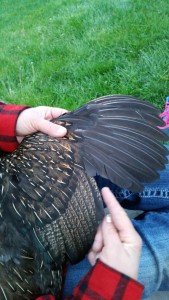
Cut wing, only cut one side!

Dusting for Mites/Lice with Food Grade Diatomaceous Earth
It is a good idea to check your hens for mites and lice each month. Most poultry owners fail to realize that lice is one of the main reasons why hens become sick, egg production decreases and death occurs. Count on your flock getting parasites, it is just part of being a chicken. With a little effort you can eliminate spread of disease and illness to your flock by just giving them a regular dust. It is good to have a place the hens can also take a dust bath on their own. The best place to start looking for parasites is around the vents of the hen (their bottoms.) This is where mites and lice especially like to gather. At first, it really grossed me out to see mites or lice but now that I have a way to kill them and keep them under control, I do not worry so much. Food grade DE works great for disposing of mites and lice. I spread the puffy feathers apart around the vents and then, using a mustard refill bottle with a pointed nozzle, I squirt DE into the feathers. I make sure it is close to the chicken skin and comes in contact with the mites.
To do a body dust for lice or mites, lay the chicken on her back holding the feet straight up (you will need someone to help keep the wings spread out). Gently pull the feathers back and using a plastic powder bottle, mustard bottle or with your hand sprinkle DE into wings, on the abdomen, leg feathers, vents and tail. (Sprinkle more DE and less air through the bottle to avoid a large dust cloud.) Gently message into the skin. Tuck wings in and roll the hen over while holding the wings. After the hen is standing, while you hold down the wings have someone apply DE through neck, back and tail feathers. Gently message the DE through the feathers to the skin. Avoid the eyes of the chicken. Repeat the dust every week until you do not notice lice or mites with inspection. I also sprinkle DE in their dust baths, nest boxes, coop floor and roosting boxes.
Ever since I have used DE, I have not noticed many (sometimes not ANY) parasites on my hens. I make sure to dust them a few times on and off during the year just in case the mites decide to come back. How often I dust determines how many parasites my hens get. Lice and mites increase in number in the Fall and Winter months. It is important to keep the coop clean. Try to dust hens on clear winter days to keep infestation down and continue to dust coop and nest boxes. Signs of parasites on your hens may include feathers falling out around bottoms and bright pink flesh, thin egg shells, decrease in egg production, lack of energy, decreased weight gain and a dull or roughened appearance from feather damage. If your hens feathers are falling out during an off molting season, it is probably a parasite. (Hens do a lot of their own preventative dusting as long as they have access to some dirt. It will make your job easier if hens are able to dust themselves.) Find out when your hens molting schedule is to diagnose easier. Thankfully, I found a few parasites early and treated them before they got to be an infestation in my flock. Lice and mites do not build up an immunity for food grade DE, which it is one reason it works so effectively.
* Wild birds can spread parasites to your flock. *
* Poultry lice are host specific and cannot be transferred to humans. *Comparison chart to distinguish between lice and mites.
Lice Mites *Size 2-3 millimeters long. 1 millimeter diameter (ground pepper.) *Speed Fast Moving. Slow Moving. *Color Straw-colored (light brown.) Dark reddish black. *Egg Location Base of feather shaft. Along feather shaft. *Egg Color White. White or off-white. * Best Detection Daytime. Nighttime or Daytime. *Location Lives only on host (especially vents.) Lives on host (especially vents) and in environment. Mites Lice Eggs Adult Lice 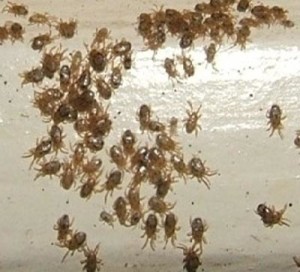
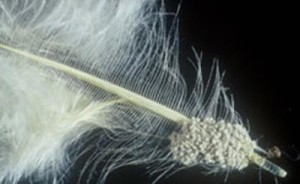
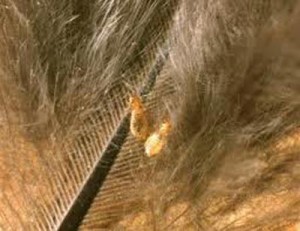
Old Fashioned Remedies for Sick Hens. (Also visit our Chicken Health Chart.)
Diarrhea is one of the most common illnesses in chickens. Your chicken’s environment and diet can contribute to diarrhea, but some simple remedies can get rid of diarrhea and can help prevent it.
Environment
1. Isolate the sick chicken if you can. Treat her until she is looking better and then let her back in with the other hens.
2. Keep environment clean and dry. Disease can spread on damp floors. Change coop shavings regularly and disinfect feeders once a year, or as you see sick hens.
3. Make sure chickens have enough room. Crowded spaces can spread disease quickly.
4. Put water containers and feeders at a height level with the backs of the birds, so they cannot defecate or scratch litter into them. Keep birds from roosting on the feeders with anti-roosting wire. Suspend water containers or put them on wire-covered platforms to help keep them clean.
Diet
1. Make sure you are feeding your hen the right foods. Chocolate, large servings of meat, raw potato skins, citrus fruits, bones, avocado skins and pits, spoiled meat and long-cut grass can all cause digestive problems in chickens.
2. I feed my hens plain yogurt once a month or more. The good bacteria in yogurt can help their diarrhea as well as keep their digestive system balanced. Make sure you use the plain yogurt. (This is not essential though, it is something I like to treat them with.)
3. Potassium permanganate can be used to treat diarrhea. (Potassium permanganate is the inorganic chemical compound with the formula KMnO4. It is a salt consisting of K+ and MnO4– ions. Formerly known as permanganate of potash or Condy’s crystals. It is a disinfectant for the drinking water.
Dissolve 1 tablespoon in 1 quart of warm water. Feed each chicken 1 tablespoon of the concentrated solution diluted in 1 cup of warm water. In a case of severe diarrhea you may need a stronger solution, one that is potent enough to turn your finger slightly brown when you dip it in the liquid. Do not keep the potassium permanganate mixture in a metal container.
4. Another thing you can try is Epsom salt. Add one-half tablespoon of Epsom salt to the affected chicken’s feed. You can also feed your diarrhea-afflicted chicken wheat bran moistened with sour milk or buttermilk.
5. Food grade diatomaceous earth has a negative charge and bacteria has a positive charge. I keep food grade DE in my chicken feed constantly to sweep out parasites and viruses from the digestive tract. Giving it to them daily can only help. I find less disease and less digestive problems as long as I am using it. Our hens have an easier time maintaining a healthy weight, growing feathers back faster after molting and better egg production.
**If diarrhea keeps occurring despite all your attempts to alleviate it, take your chicken to the vet. Your bird could have a serious illness that requires further medical treatment. **





